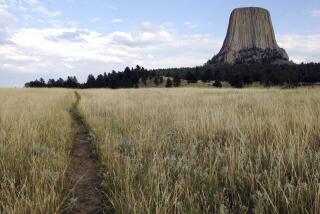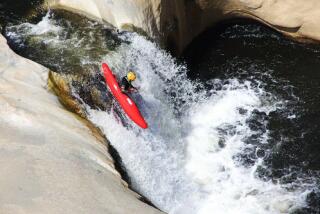Harrowing stories emerge after two massive rockfalls at Yosemiteâs El Capitan
Harrowing stories are emerging about two massive rockfalls at Yosemite National Park that killed one man and injured at least two others this week.
A British tourist died Wednesday while climbing the parkâs El Capitan monolith, and U.K. media reports quoted relatives saying the man was killed while trying to save his wife.
Another fall occurred Thursday. The wife of the man injured during that rockfall described the tense moments in which debris blanketed their vehicle and sent them and others scrambling for cover.
Rachel Evans was with her husband, Jim, who was driving, and her sister and brother-in-law when massive chunks of rock separated from El Capitan and dropped hundreds of feet to the ground below, Evans told KSEE.
âSomething came through our sunroof, but we didnât know it was closed. We didnât know what had happened, but it shattered and dust just poured in,â a visibly shaken Evans told the station. âSo we were trying to outrun it and was like, âGo! Letâs go!â and at the same time, my husband reached up and was like, âOh, my head. My head,â because he was bleeding profusely.â
Thursdayâs rockfall was believed to be larger than the deadly fall the previous day.
âIt couldâve been a lot worse,â said Ken Yager, president of the Yosemite Climbing Assn., who saw the aftermath of Thursdayâs incident. âFrom what I hear, we got really lucky.â
A rock the size of a golf ball could be fatal, he said, and he estimated Thursdayâs fall was â10 times biggerâ than the colossal chunk that broke off a day earlier.
âThat anybody survived, it just blows my mind,â he said.

Sharon and Doug Hansen were in Yosemite National Park watching climbers on El Capitan when they heard the rock slide begin. Doug began filming about a minute after the slide began and captured the billowing clouds of dust that blew through the trees
Yager was coordinating a park cleanup Thursday when he saw a dust cloud, from about a mile away, billowing from the formation. Immediately, his phone began buzzing as people tried to figure out what had happened and emergency crews rolled to the scene.
âAfter [Wednesday], I guarantee thereâs no climbers climbing near that rock,â he said. âIf they were, theyâre crazy.â
A British newspaper reported that Andrew Foster, the Welsh climber killed by falling rock Wednesday, died while trying to shield his wife.
Fosterâs wife, Lucy, told her husbandâs aunt that he jumped to cover her as tons of rock came cascading down the face of El Capitan, a 3,600-foot granite monolith that attracts climbers from around the world.
In an interview published Saturday with Britainâs Times newspaper, Gillian Stephens said Lucy Foster told her: âAndrew saved my life. He dived on top of me as soon as he could see what was going to happen. He saved my life.â
The couple, who lived in Cardiff, Wales, described their love of the outdoors in a blog, Cam and Bear.
Dramatic photos posted on social media by witnesses showed a plume of dust billowing from the rock formation after the rockfall Wednesday. After the dust cleared, a massive white scar was left behind.
Yosemite Valley, with its steep, glacier-carved cliffs, has seen many rockfalls, though fatalities are rare. In more than a century of record-keeping, rockfalls at Yosemite have resulted in at least 17 fatalities, 85 injuries and damage to buildings, roads and trails, according to news and park reports. Most occur during periods of heavy rain, snowmelt or cold temperatures.
Geologists actively monitor the rock walls and hillsides throughout the park, officials have said.
As scientists have come to learn, the domes and arches carved into the parkâs famed granite cliffs are constantly moving, according to a study published last year in Nature Geoscience.
âGranite rocks, any kind of rock, is more dynamic than people realize â pieces are falling off, theyâre constantly changing,â Yager said. âOver the course of the years, these features gradually loosen ⌠until one day, itâs just a catastrophic release.â
The dramatic rock formations were created as layers of rock peeled away from the mountainsides, like an onion. The flakes remain attached at a few points but are completely hollow in the middle.
In Yosemite, these precarious attachments â geologists call them âexfoliationsâ â fall at a rate of one a week, on average. Most often, they collapse because water repeatedly freezes and thaws in the cracks, destabilizing the cliffs. Sometimes they fall apart during an earthquake.
Other times, though, rockfalls happen on sunny days with no sign of rain or seismic activity. Now geologists from the U.S. Geological Survey and the National Park Service have found a potential cause for the seemingly spontaneous rockfalls: heat.
As the temperature rises from morning to afternoon, the thin outer layer of rock moves ever so slightly away from the cliff, then returns as the evening cools.
As the cliffs inhale and exhale, so to speak, the tips of the cracks weaken. Over time, the cracks slowly open wider and the stress from the heat can prompt the rocks to fall.
Park officials have said the falls donât increase the overall dangers in the area. And climbers continued to trek through on Saturday.
Hayden Jamieson, 24, of Mammoth Lakes, Calif., told the Associated Press on Friday that he planned to head up El Capitan early Saturday.
âItâs kind of an inherently dangerous sportâ but Jamieson said he felt more at risk of being struck by a car on the street than from a falling slab of granite in the wilderness.
Times writer Sean Greene and the Associated Press contributed to this report.
ALSO
Coastal Commission will consider relaxing L.A.âs 30-year-old beach curfew
Think you might challenge that marijuana shopâs city license? L.A. might stand in your way
UPDATES:
12:15 p.m.: This article was updated with details about climbers continuing to trek El Capitan.
This article was originally published at 8:15 a.m.
More to Read
Sign up for Essential California
The most important California stories and recommendations in your inbox every morning.
You may occasionally receive promotional content from the Los Angeles Times.












